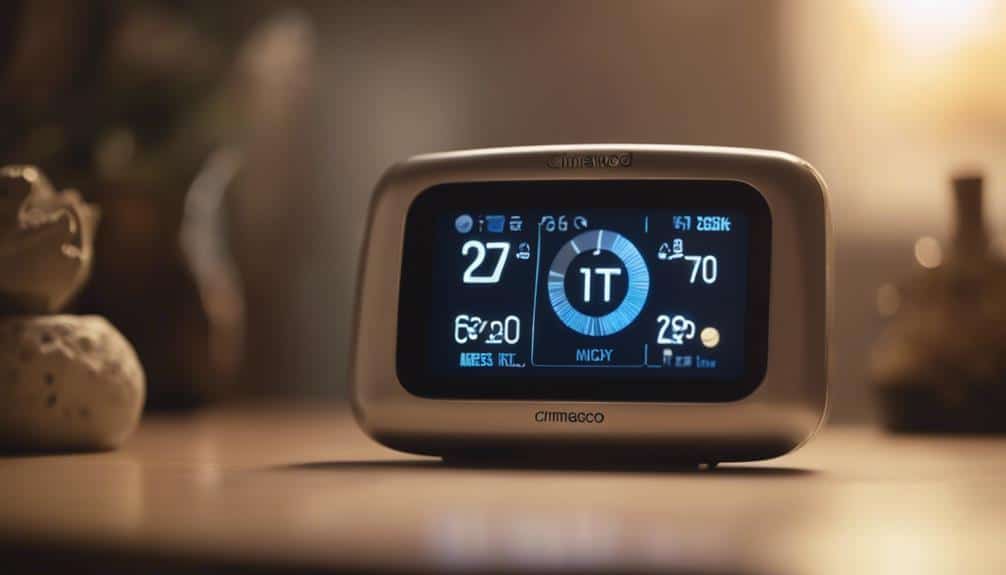Ah, the modern thermostat: a device so intuitive, it often feels like you need a degree in rocket science to program it.
But worry not, because you've got this. To start, let's get a grip on your daily shuffle—knowing when you're up and about or out cold is essential.
Then, we'll discuss setting those temperatures just right, so your energy bill doesn't make you weep.
Last but not least, we'll delve into how to get that schedule into your thermostat without pulling your hair out.
Stick around, and you'll find out how to make your thermostat bend to your will, making your home more comfortable and your wallet a bit thicker.
Key Takeaways
- Adjust thermostat settings to match your daily routine for enhanced comfort and energy efficiency.
- Set the temperature lower in winter and higher in summer when away to save on energy costs.
- Utilize programmable or smart thermostats for automatic temperature adjustments based on your schedule.
- Consistently maintain your thermostat schedule to balance home comfort with energy savings.
Understand Your Routine
To kick off programming your thermostat effectively, let's first pin down your daily routine, considering when you wake up, leave, return, and hit the hay. Knowing the ebb and flow of your day is essential for setting up your thermostat to match your life's rhythm.
By tailoring your thermostat settings to your daily routines, you not only enhance your home's comfort but also boost energy efficiency. Whether it's heating or cooling, adjusting the temperature according to when you're actually home or away can lead to substantial energy savings.
This approach guarantees that you're not wasting energy heating an empty house or cooling rooms no one's using. It's all about optimizing your thermostat schedule to align perfectly with your lifestyle, making your home more energy-efficient and comfortable.
Select Optimal Temperatures

Having established your daily routine, it's time to select the best temperatures for your home that align with your schedule and promote energy savings.
In colder months, setting your home temperature to 68°F guarantees ideal comfort and efficiency. Remember, maintaining a 7 to 10 degrees difference between your home, away, and sleep temperature set points greatly reduces energy costs.
During warmer months, adjusting your thermostat higher when away slashes cooling costs. Utilizing smart or programmable thermostats makes these adjustments effortless, optimizing your home's comfort and your HVAC system's efficiency.
Seasonally adjusting your thermostat settings further enhances energy savings. By thoughtfully programming your thermostat according to these guidelines, you're on your way to achieving a balance between home comfort and energy savings.
Implement the Schedule

Once you've chosen the ideal temperatures, it's time to program your thermostat to match your daily routine, guaranteeing your home's comfort and energy efficiency. Begin by setting specific temperature and time parameters for different periods of the day, such as wake up, leave home, return home, and bedtime.
This customization allows you to automate temperature adjustments that synchronize perfectly with your schedule. Don't forget to activate the schedule on your thermostat to guarantee these changes occur seamlessly every day.
Maintaining consistency in following this programmed schedule is essential for maximizing energy efficiency and maintaining comfort. By taking these steps, you'll guarantee your thermostats work tirelessly in the background, adjusting the climate of your home to match your life's rhythm.
Frequently Asked Questions
How Should I Set My Thermostat Schedule?
To set your thermostat, consider seasonal adjustments and vacation mode for energy savings. Balance comfort at night with appropriate settings, and use zoned heating with manual override. Integrate smart options for user preferences and temperature thresholds.
What Are the Three Settings on a Thermostat?
The three settings on your thermostat – 'Heat,' 'Cool,' and 'Off' – let you adjust temperature zones, ensuring comfort levels and energy savings. Features like manual override, vacation mode, and smart integration enhance usability and efficiency.
What Is the Most Efficient Way to Set a Programmable Thermostat?
To set your programmable thermostat efficiently, focus on energy savings by adjusting for comfort levels, making seasonal adjustments, and using zone control. Enable smart integrations for automatic adjustments based on temperature thresholds and your usage patterns.
What Is the Best Thermostat Strategy?
The best strategy maximizes comfort and energy savings. You'll want to use smart integrations, learning capabilities, and remote access for seasonal adjustments and zoning controls. Don't forget manual overrides and maintenance alerts to suit your preferences.
Conclusion
Wrapping up, it's all about making your thermostat work for you. Get to know your daily routine like the back of your hand, choose temperatures that keep both your comfort and savings in check, and then set it all up.
By doing this, you'll not only make your home more comfortable but also see significant savings on your energy bills. Remember, a little effort in setting things up can lead to a lot of relaxation and savings down the road.

